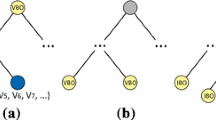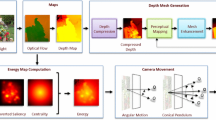Abstract
For an illustration to fulfill the purposes for which it is designed, it is often important that certain objects depicted not be blocked by others. We describe an automated approach to the problem of generating illustrations that satisfy a set of visibility constraints for a given viewing specification. We introduce a family of algorithms that automatically identify potentially obscuring objects, and render them using cutaway and ghosting effects modeled after those used by illustrators. These algorithms exploit modernz-buffer-based 3D graphics hardware to make possible dynamic illustrations that maintain a set of visibility constraints as a user interactively updates the viewing specification.
Similar content being viewed by others
References
Appel A, Rohlf F, Stein A (1979) The haloed line effect for hidden line elimination. Proc ACM SIGGRAPH Comput Graph 13(2):151–157
Chin N, Feiner S (1989) Near real-time shadow generation using BSP trees. Proc ACM SIGGRAPH Comput Graph 23(3):99–106
Chin N, Feiner S (1992) Fast object-precision shadow generation for area light sources using BSP trees. Proc Symp Interactive 3D Graphics. Special Issue on 1992 Symp on Interactive 3D, Comput Graph, pp 21–30
Crow F (1977) Shadow algorithms for computer graphics. Proc ACM SIGGRAPH Comput Graph 11(3):242–248
Culbert C (1991) CLIPS reference manual (Version 5.0). NASA Johnson Space Center, Information Systems Directorate, Software Technology Branch, Houston
Dooley D, Cohen M (1990a) Automatic illustration of 3D geometric models: lines. Proc Symp Interactive 3D Graphics. Comput Graphics 24(2):77–82
Dooley D, Cohen M (1990b) Automatic illustration of 3D geometric models: surfaces. Proc Visualization, pp 307–314
Feiner S, McKeown K (1990) Coordinating text and graphics in explanation generation. Proc AAAI, pp 442–449
Feiner S, McKeown K (1991) Automating the generation of coordinated multimedia explanations. IEEE Comput 24(10):33–41
Kamada T, Kawai S (1987) An enhanced treatment of hidden lines. ACM Trans Graph 6(4):308–323
Kamada T, Kawai S (1988) Advanced graphics for visualization of shielding relations. Comput Vision, Graph, Image Process 43(3):294–312
Karp P, Feiner S (1990) Issues in the automated generation of animated presentations. Proc Graph Interface, pp 39–48
Martin J (1989) High tech illustration. North Light Books, Cincinnati
Naylor B (1990) SCULPT: an interactive solid modeling tool. Proc Graph Interface, pp 138–148
Seligmann D, Feiner S (1989) Specifying composite illustrations with communicative goals. Proc ACM SIGGRAPH Symp on User Interface Software and Technology, pp 1–9
Seligmann D, Feiner S (1991) Automated generation of intentbased 3D illustrations. Proc ACM SIGGRAPH Comput Graphics 25(4):123–132
Saito T, Takahashi T (1990) Comprehensible rendering of 3-D shapes. Proc ACM SIGGRAPH Comput Graph 24(4):197–206
Thomas TA (1968) Technical illustration (2nd ed). McGraw-Hill, New York
Thibault W, Naylor B (1987) Set operations on polyhedra using binary space partitioning trees. Proc ACM SIGGRAPH Comput Graph 21(4):153–162
Author information
Authors and Affiliations
Rights and permissions
About this article
Cite this article
Feiner, S.K., Seligmann, D.D. Cutaways and ghosting: satisfying visibility constraints in dynamic 3D illustrations. The Visual Computer 8, 292–302 (1992). https://doi.org/10.1007/BF01897116
Issue Date:
DOI: https://doi.org/10.1007/BF01897116




